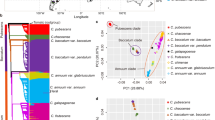Abstract
Capsinoids have similar biological effects as capsaicinoids, including anticancer and anti-obesity properties. The Capsicum chinense ‘SNU11-001’ variety of pepper was previously reported to contain high levels of capsinoids due to a mutation in the putative aminotransferase (pAMT) gene, which leads to production of the capsinoid precursor vanillyl alcohol. Here, to develop Capsicum annuum pepper varieties with high capsinoid contents, marker-assisted backcrossing was performed during backcross breeding. For foreground selection, plants carrying the pAMT/pamt genotype were selected from BC1F1 and BC2F1 populations using SCAR markers derived from the unique pamt mutation of ‘SNU11-001.’ To obtain background selection markers, 412 single nucleotide polymorphism (SNP) markers were screened to identify SNP markers polymorphic between the ‘Shinhong’ paternal lines and ‘SNU11-001.’ Of the 412 SNP markers, 204 polymorphic SNP markers evenly distributed in pepper genome were selected. BC1F1 and BC2F1 plants carrying the pAMT/pamt genotype were subjected to background selection using these SNP markers. Multiple genotypes were analyzed using a high-throughput genotyping system. As a result, one BC1F1 plant 84 % similar to the recurrent parent and seven BC2F1 plants showing more than 96 % recovery of the recurrent parent genotype were selected. Genetic backgrounds of the selected BC2F1 plants were evaluated using the genotype-by-sequencing (GBS) method to confirm the background selection results from the SNP marker set. GBS results showed that the recovery rate and positions of introgressed segments were well matched between two methods, demonstrating MABC can be successfully performed with only ~200 SNP markers.


Similar content being viewed by others
References
Collard BC, Mackill DJ (2008) Marker-assisted selection: an approach for precision plant breeding in the twenty-first century. Philos Trans R Soc Lond B Biol Sci 363:557–572
Curry J, Aluru M, Mendoza M, Nevarez J, Melendrez M, O’Connell MA (1999) Transcripts for possible capsaicinoid biosynthetic genes are differentially accumulated in pungent and non-pungent Capsicum spp. Plant Sci 148:47–57
Doyle JJ, Doyle JL (1987) A rapid DNA isolation procedure for small quantities of fresh leaf tissue. Phytochem Bull 19:11–15
Han K, Jeong HJ, Sung JH, Keum YS, Cho MC, Kim JH, Kwon JK, Kim BD, Kang BC (2013) Biosynthesis of capsinoid is controlled by the Pun1 locus in pepper. Mol Breed 31:537–548
Herzog E, Frisch M (2011) Selection strategies for marker-assisted backcrossing with high-throughput marker systems. Theor Appl Genet 123:251–260
Hospital F, Charcosset A (1997) Marker-assisted introgression of quantitative trait loci. Genetics 147:1469–1485
Hospital F, Chevalet C, Mulsant P (1992) Using markers in gene introgression breeding programs. Genetics 132:1199–1210
Jang S, Han K, Jo YD, Jeong HJ, Siddique MI, Kang BC (2015) Substitution of a dysfunctional pAMT allele results in low-pungency but high levels of capsinoid in Capsicum chinense ‘Habanero’. Plant Breed Biotechnol 3:119–128
Johnston TD (1974) Transfer of disease resistance from Brassica campestris L. to rape (B. napus L.). Euphytica 23:681–683
Kang JH, Yang HB, Jeong HS, Choe P, Kwon JK, Kang BC (2014) Single nucleotide polymorphism marker discovery from transcriptome sequencing for marker-assisted backcrossing in Capsicum. Korean J Hortic Sci 32:535–543
Kim C, Guo H, Kong W, Chandnani R, Shuang LS, Paterson AH (2015) Application of genotyping by sequencing technology to a variety of crop breeding programs. Plant Sci. doi:10.1016/j.plantsci.2015.04.016
Kobata K, Sugawara M, Mimura M, Yazawa S, Watanabe T (2013) Potent production of capsaicinoids and capsinoids by Capsicum peppers. J Agric Food Chem 61:11127–11132
Lang Y, Kisaka H, Sugiyama R, Nomura K, Morita A, Watanabe T, Tanaka Y, Yazawa S, Miwa T (2009) Functional loss of pAMT results in biosynthesis of capsinoids, capsaicinoid analogs, in Capsicum annuum cv. CH-19 Sweet. Plant J 59:953–961
Randhawa HS, Mutti JS, Kidwell K, Morris CF, Chen X, Gill KS (2009) Rapid and targeted introgression of genes into popular wheat cultivars using marker-assisted background selection. PLoS ONE. doi:10.1371/journal.pone.0005752
Sasahara I, Furuhata Y, Iwasaki Y, Inoue N, Sato H, Watanabe T, Takahashi M (2010) Assessment of the biological similarity of three capsaicin analogs (capsinoids) found in non-pungent chili pepper (CH-19 Sweet) fruits. Biosci Biotechnol Biochem 74:274–278
Stoskopf NC, Tomes DT, Christie BR (1993) Plant breeding: theory and practice. Westview Press, Boulder
Tanaka Y, Hosokawa M, Miwa T, Watanabe T, Yazawa S (2010a) Newly mutated putative-aminotransferase in nonpungent pepper (Capsicum annuum) results in biosynthesis of capsinoids, capsaicinoid analogues. J Agric Food Chem 58:1761–1767
Tanaka Y, Hosokawa M, Miwa T, Watanabe T, Yazawa S (2010b) Novel loss-of-function putative aminotransferase alleles cause biosynthesis of capsinoids, nonpungent capsaicinoid analogues, in mildly pungent chili peppers (Capsicum chinense). J Agric Food Chem 58:11762–11767
Tanaka Y, Yoneda H, Hosokawa M, Miwa T, Yazawa S (2014) Application of marker-assisted selection in breeding of a new fresh pepper cultivar (Capsicum annuum) containing capsinoids, low-pungent capsaicinoid analogs. Sci Hortic 165:242–245
Voorrips R (2002) MapChart: software for the graphical presentation of linkage maps and QTLs. J Hered 93:77–78
Yazawa S, Suetome N, Okamoto K, Namiki T (1989) Content of capsaicinoids and capsaicinoid-like substances in fruit of pepper (Capsicum annuum L.) hybrids made with “CH-19 Sweet” as a Parent. J Jpn Soc Hortic Sci 58:601–607
Acknowledgments
This research was supported by Golden Seed Project (213002-04-3-CG900), Ministry of Agriculture, Food and Rural Affairs (MAFRA), Ministry of Oceans and Fisheries (MOF), Rural Development Administration (RDA) and Korea Forest Service (KFS), and a Grant (710001-07) from the Vegetable Breeding Research Center through Agriculture, Food and Rural Affairs Research Center Support Program, Ministry of Agriculture, Food and Rural Affairs, Republic of Korea.
Author information
Authors and Affiliations
Corresponding author
Electronic supplementary material
Below is the link to the electronic supplementary material.
Rights and permissions
About this article
Cite this article
Jeong, HS., Jang, S., Han, K. et al. Marker-assisted backcross breeding for development of pepper varieties (Capsicum annuum) containing capsinoids. Mol Breeding 35, 226 (2015). https://doi.org/10.1007/s11032-015-0417-z
Received:
Accepted:
Published:
DOI: https://doi.org/10.1007/s11032-015-0417-z



